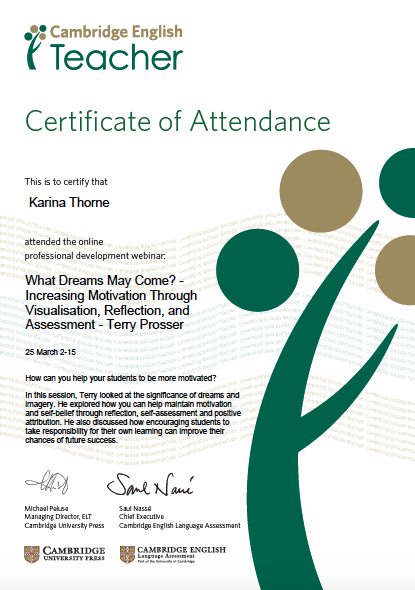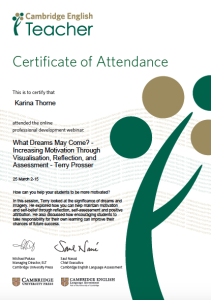What Dreams May Come?
Describing myself as a visual learner, I was very pleased to see the use of images take centre stage of this webinar. Indeed, photographs, pictures and drawings are all great ways to stimulate ideas and encourage reflection in the classroom. The webinar presenter, Terry Prosser, gave us lots of ideas for increasing motivation, including using visions as a way to connect with students in the present and lead them towards a better future. If this sounds like Psychology 101, then that’s probably because it is! Indeed, assessing what students would like to become and/or may be afraid of becoming, may be equally related to extrinsic, intrinisic and integrative motivation.
Imagine the Future
One way we can use visions is by calling to mind an Imaginary Future. This can be done through Controlled Daydreaming (see below), Guided Imagery (the teacher may inspire visions with verbal prompts), Sharing Experiences (post-visualisation, students may reflect on where they were, what they did and said with a partner or in small groups) and Image Boards (using magazine/newspaper pictures).
Here’s a simple Attentive Daydreaming technique that I found on a hynotherapy blog that you might like to adapt for your classroom:
- Find a quiet, comfortable spot, away from distractions
- Set a time limit, e.g. 10 minutes
- Say to yourself “I will spend the next 10 minutes calmly observing my thoughts”
- Allow your mind to wander
You may want your students to write down their thoughts after, and/or share their ideas with others as, “Allowing the mind to roam freely can aid creativity, but only if we pay attention to the content of our daydreams.” This is a great quote from the same blog, taken from the book Living in a Dream World: The Role of Daydreaming in Problem Solving and Creativity by Josie Glausuisz.
Key Take-Aways
In terms of language learning, all students want to be seen as “good at…” insert language here. However, we teachers should not confuse achievement with ability, as this may seriously decrease student motivation. According to Covington’s Self-worth Theory, the highest human priority is the search for self-acceptance (Covington & Beery, 1976; Covington, 1984) and that “one’s worth often comes to depend on the ability to achieve competitively” (Covington, 1998, p. 78). So, in order to detach self-worth and school achievement, I think that it is better to praise and reward effort made by all students, rather than just the ‘best performing’ students.
I also was greatly inspired by the idea of a self-fulfulling prophesy, where reality can be influenced by the expectation of an individual. In other words, if a student percieves that he/she is doing well then this will translate into successful outcomes. Therefore, teachers can facilitate achievement by praising contribution and encouraging all students to develop self-awareness and the ability to self-assess. As per the Pygmalion Effect image above, this positive reflection will, in turn, stimulate further interest in the subject, and maintain motivation.
References
Weibell, C. J. (2011). Principles of learning: 7 principles to guide personalized, student-centered learning in the technology-enhanced, blended learning environment. Retrieved April 21, 2015 from [https://principlesoflearning.wordpress.com]



